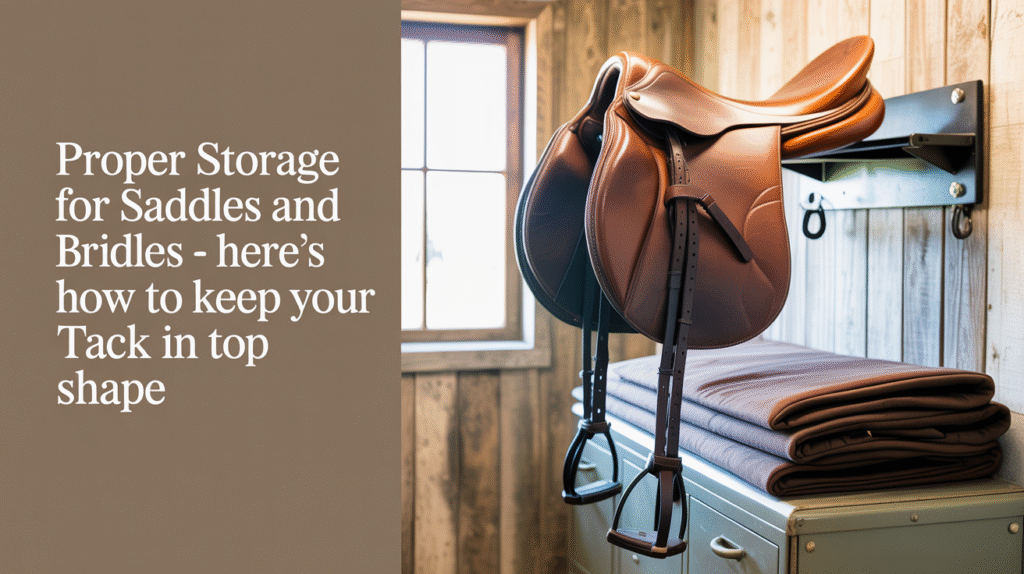The best way to store saddles and bridles is in a cool, dry, and well-ventilated area using racks or hangers that maintain their shape and prevent moisture buildup. Improper tack storage leads to mold, warping, cracking, and even leather breakdown. Whether you’re managing a home barn or a professional stable, investing time in proper tack storage extends the lifespan of your equipment and ensures it’s safe and ready for every ride.

Let’s go over the most effective tack storage methods and the key mistakes to avoid.
Why Proper Tack Storage Is Essential
Proper storage isn’t just about organization – it’s a critical part of tack maintenance and horse care.
Prevents Damage and Deformation
Tack that’s stored incorrectly can quickly lose its shape and functionality.
- Leather can crack or warp if it’s bent, folded, or compressed improperly.
- Mold and mildew develop easily in dark or humid environments.
Increases Longevity and Saves Money
Well-stored tack lasts longer, reducing the need for costly repairs or replacements.
- Protects stitching and padding from unnecessary wear.
- Preserves conditioning treatments and keeps surfaces supple.
Best Practices for Saddle Storage
Keeping your saddle in good condition starts with how and where you store it.
Use a Proper Saddle Rack
The rack should mimic the shape of a horse’s back to prevent sagging.
- Metal or wooden saddle racks: Provide sturdy support and maintain saddle shape.
- Wall-mounted or freestanding options: Based on space and convenience.
Keep It Off the Floor
Avoid placing saddles directly on the ground, even temporarily.
- Reduces dust accumulation and damp exposure.
- Prevents accidental kicking or damage from foot traffic.
Cover When Not in Use
A breathable cover protects the saddle from dust while allowing air circulation.
- Avoid plastic covers: They trap moisture and promote mildew.
- Use cotton or canvas saddle covers: For dust protection and airflow.
Best Practices for Bridle Storage
Bridles are more delicate and need to hang properly to avoid stretching or tangling.
Use Bridle Hooks or Hangers
Dedicated hooks maintain the bridle’s shape and prevent leather fatigue.
- Hang by the crownpiece: Keeps parts aligned and tangle-free.
- Avoid sharp hooks: Rounded ends are better for preventing creases.
Separate by Use or Horse
Organizing bridles makes daily routines easier and keeps tack in good condition.
- Label hooks: Especially in busy barns or shared spaces.
- Store bits clean and dry: To prevent corrosion or grime buildup.
Avoid Folding or Stuffing
Folding a bridle into a box or bag causes damage over time.
- Maintain natural shape: Hanging prevents stress on leather joints.
- Untangle reins and straps: So they don’t stretch or crack.
Environmental Conditions Matter
Your tack room’s climate plays a major role in tack preservation.
Keep the Area Cool and Dry
Humidity is one of leather’s biggest enemies.
- Ideal humidity: 40–50%: Use a dehumidifier if necessary.
- Ventilated rooms prevent mold: Avoid sealed containers or airless rooms.
Avoid Direct Sunlight and Heat
Sunlight fades leather and weakens it structurally.
- Store tack away from windows: Or use UV-blocking curtains.
- No heaters near leather: Heat dries it out and causes cracking.
Organizing Your Tack Room for Long-Term Efficiency
Organization supports both cleanliness and convenience.
Designated Sections for Each Item
Having a logical system keeps everything within reach and reduces stress on gear.
- Separate saddles, bridles, pads, and grooming tools.
- Add hooks, shelves, and bins: Helps keep small items like stirrups and oils tidy.
Use Cleaning and Conditioning Stations
Build a small area to clean and condition your tack before storage.
- Include hooks for drying clean tack.
- Use saddle stands for inspections or repairs.
FAQs
Here are some questions and answers about proper storage for saddles and bridles:
What’s the best way to store a saddle long-term?
Use a saddle rack that supports the full panel and tree. Keep it in a cool, dry, and dark location with a breathable cover over it. Check monthly for mold or dryness.
Can I store a bridle in a plastic bin?
It’s not recommended. Plastic traps moisture and promotes mold. Use an open-air bridle hook or a cotton-lined tack bag that allows ventilation.
How do I prevent mold on tack in humid areas?
Use a dehumidifier in the tack room, avoid airtight containers, and regularly clean and condition tack. Wipe down gear after every ride and allow it to air dry before storing.
Is it okay to leave my saddle in the barn aisle temporarily?
Avoid it when possible. Barn aisles are exposed to dust, sunlight, and risk of being knocked over. Even short-term exposure can lead to damage or accidents.
Do synthetic saddles and bridles need the same storage care?
They’re more resistant to moisture but still benefit from clean, organized, and supportive storage. Avoid excessive heat and UV exposure even with synthetics.
Proper tack storage protects your investment, your horse’s comfort, and your own riding safety. By following these storage strategies and avoiding common mistakes, you’ll keep your saddles and bridles in ride-ready condition for years to come.